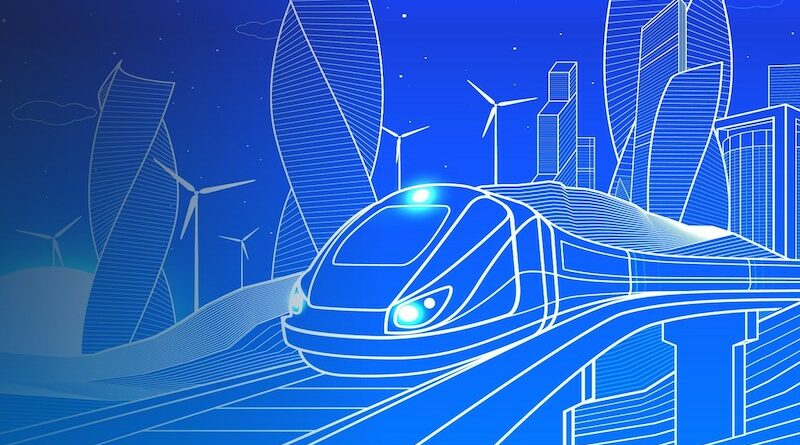
Leveraging the many benefits of high-speed rail
Responsible for the movement of people and goods, transportation is the backbone of European society and the internal market. It’s also responsible for nearly a quarter of the EU’s total greenhouse gas emissions1.
If the EU is to meet its ambitious climate goal of becoming carbon neutral by 2050, it must significantly cut transportation’s carbon footprint.
A good place to start is by increasing rail’s total share of passenger traffic – which currently sits at a mere 7%2.
When less is more
Producing less CO2, consuming less energy, and taking up less space than road and air transport, rail is one of the most sustainable forms of mobility. There is an opportunity in Europe to exploit, enhancing and expanding, Europe’s rail network taking advantage of the latest innovations. That is why Europe’s Rail Joint Undertaking – the European partnership on rail research and innovation – has been looking into it, particularly for the high-speed rail network.
High-speed rail, or HSR, is a general term used to describe a rail system that can run much faster than traditional rail – with trains travelling at speeds of 200 km/h or higher.
The last 20 years has seen Europe’s HSR network grow substantially, with the network now providing high-speed transport along nearly 15 000 km of HSR tracks that crisscross Europe.
But a new report3 on the benefits of HSR, commissioned by Europe’s Rail and produced by Ernst and Young and Bocconi University, in collaboration with ALLRAIL, CER and UNIFE, found that HSR is about more than just high-speed travel, it also provides a plethora of societal, economic and environmental benefits, especially when compared to other modes of transportation.
Decreased levels of CO2 and air pollutants per passenger kilometre, as well as increased safety, have positioned HSR as the most sustainable form of transport. Thanks to its high energy efficiency and ability to power transport using increasingly sustainable electricity, HSR is many times less emission-intense than other forms of transportation, including road and air travel. In fact, in some parts of Europe, HSR is on track to deliver the transport alternatives required to reach the EU’s overall decarbonisation objectives.
Good for people and communities too
HSR isn’t just good for the environment – it’s good for people too. When asked why they pick HSR over other forms of transport, many passengers cite comfort (more leg room, less noise and vibration!), competitive travel times, a comparative ease of boarding, the possibility of city-to-city connections, and the ability to carry out work or enjoy leisure time alone, with family or even pets while onboard.
And let’s not overlook the many benefits HSR brings to communities and regions. For starters, it stimulates economic development by connecting citizens and regional businesses through a fast and competitive alternative to road transportation. It also increases local productivity and accessibility, boost economies, and lowers traffic congestion – altogether improving the quality of life for the communities it serves.
By acting as a practical alternative to short-haul flights, HSR can even help alleviate the capacity pressure that many European airports are currently facing.
Delivering on HSR’s potential
HSR clearly has the potential to help Europe meet its climate goals and decrease its dependency on foreign fuel, all while creating a better-connected Europe for its citizens and the economy. However, delivering on this potential requires having a comprehensive, efficient, and pan-European HSR network in place, which currently isn’t the case.
The reality is that most high-speed lines are concentrated in Western Europe, with HSR being nearly non-existent in much of central and eastern Europe. The current HSR network is also full of bottlenecks and gaps, making a seamless HSR transport experience across Europe nearly impossible. Instead, passengers must fill in these service gaps via personal vehicles or by catching a flight – essentially negating HSR’s climate and energy benefits.
The joint HSR study4 clearly shows that investing in a comprehensive European HSR network will deliver added value to European society and massively reduce the environmental footprint of European passenger transport. That’s why it is important to work for a future where every European will be able to travel across Europe by high-speed rail.
The passengers will be attracted
With the goal of creating a European HSR network that connects all EU capitals and major cities, the European Commission wants to double HSR traffic by 2030 and triple it by 2050 and this is require also significant sector investments, exploiting the outputs of the investment in R&I done in Europe’s Rail and elsewhere.
Investments in a modern and attractive rail and more particular HSR that has the proven ability to decrease carbon emissions, increase connectivity, and boost productivity and economic activity across the Continent seems to be the right choice to make for a sustainable future.
Passengers will be attracted because HSR journey’s will be a fast, convenient, affordable, and comfortable way to travel between cities. As rail’s share of passenger traffic increases, Europe will see the substantial decrease in congestion and transport-related carbon emissions it needs to become climate neutral by 2050.
1 https://www.eea.europa.eu/en/topics/in-depth/transport-and-mobility
2 https://ec.europa.eu/commission/presscorner/detail/en/ip_20_2528




